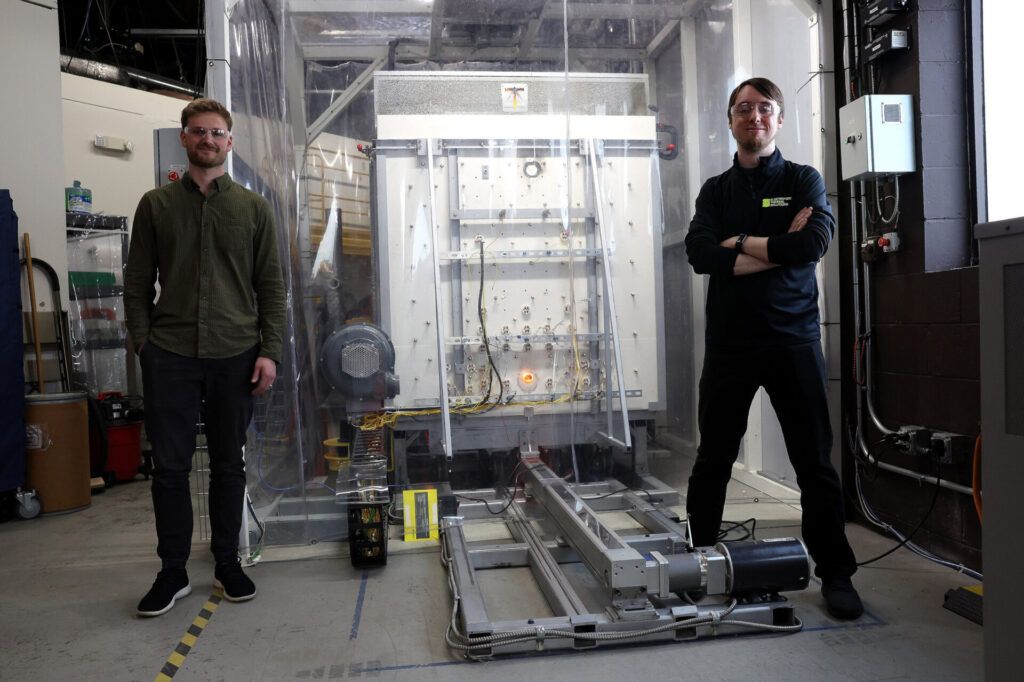Can electrically conductive bricks replace fossil fuels?
By Phil McKenna | May 27, 2024
 Joey Kabel (left) and Dan Stack, co-founders of Electrified Thermal Solutions in Medford, Mass., stand next to the company’s elevator-sized pilot system which contains electrically charged bricks that generate and store heat. Credit: Barry Chin/The Boston Globe
Joey Kabel (left) and Dan Stack, co-founders of Electrified Thermal Solutions in Medford, Mass., stand next to the company’s elevator-sized pilot system which contains electrically charged bricks that generate and store heat. Credit: Barry Chin/The Boston Globe
Editor’s note: This story was originally published by Inside Climate News. It appears here as part of the Climate Desk collaboration.
Inside a cinder block office building perhaps best known for the Hindu temple and table tennis club next door, a startup company in Medford, Massachusetts, is testing what may be one of the hottest new developments in clean energy technology.
At the back of a small warehouse laboratory buzzing with fans and motors, an MIT spinoff company called Electrified Thermal Solutions is operating something its founders call the Joule Hive, a thermal battery the size of an elevator.
The Hive is a large, insulated metal box loaded with dozens of white-hot ceramic bricks that convert electricity to heat at temperatures up to 1,800 degrees Celsius—well beyond the melting point of steel—and with enough thermal mass to hold the heat for days.
As the price of renewable energy continues to plummet, one of the biggest challenges for the clean energy transition is finding a way to convert electricity to high temperature heat so societies don’t have to continue burning coal or natural gas to power heavy industries. Another thorny issue is finding a way to store energy—in this case heat—for when the sun doesn’t shine and the wind doesn’t blow.
“If you are running an industrial plant where you’re making cement or steel or glass or ceramics or chemicals or even food or beverage products, you burn a lot of fossil fuels,” Daniel Stack, chief executive of Electrified Thermal Solutions, said. “Our mission is to decarbonize industry with electrified heat.”
The industrial sector accounts for nearly one-fourth of all direct greenhouse gas emissions in the United States, which drive climate change, according to the EPA. Thermal batteries powered by renewable energy could reduce roughly half of industry’s emissions, according to a 2023 report by the Center for Climate and Energy Solutions, a nonprofit, and its affiliated Renewable Thermal Collaborative.
Additional emissions come from chemical reactions, such as carbon dioxide that is formed as an unwanted byproduct during cement production, and from methane that leaks or is intentionally vented from natural gas pipes and other equipment.
The challenge to replacing fossil fuel combustion as the go-to source for heat, is that there aren’t a lot of good options available to produce high temperature heat from electricity, Stack said. Electric heaters, like the wires that turn red hot in a toaster, work well at low temperatures but quickly burn out at higher temperatures. Other, less common materials like molybdenum and silicon carbide heaters can withstand higher temperatures, but are prohibitively expensive.
As a grad student at MIT, Stack wondered if firebricks, the bricks commonly used in residential fireplaces and industrial kilns, could be a less expensive, more durable solution. Bricks do not typically conduct electricity, but by slightly altering the recipe of the metal oxides used to make them, he and ETS co-founder Joey Kabel were able to create bricks that could essentially take the place of wires to conduct electricity and generate heat.
“There’s no exotic metals in here, there’s nothing that’ll burn out,” Stack said standing next to shelves lined with small samples, or “coupons,” of brick that he and his team have tested to find the ones with the best heating properties.
One of Electrified Thermal Solution’s biggest champions is MIT nuclear engineering research scientist Charles Forsberg, Stack’s former thesis advisor and an advisor to the company.
“I have no doubt that this is going to go commercial,” Forsberg, who, along with Stack and MIT hold the patent to the technology, said. “I’m 77, it’s just sort of an intuitive feel of 50 years in the game.”
Forsberg said his only concern was whether Electrified Thermal Solutions would be the ones to bring the technology to fruition, noting that many clean energy technologies have been invented in the United States only to gain commercial success in China.
Recent government funding has given the company a significant boost.
In January, ETS received a $5 million US Energy Department grant to help build its first commercial-scale demonstration project at the Southwest Research Institute in San Antonio, an independent organization that provides contract research and development services to government and industrial clients.
The project will demonstrate how the thermal battery could provide high temperature heat for a number of industrial processes including cement manufacturing, which currently relies primarily on burning coal for heat.
Massimo Toso, president and chief executive of Buzzi Unicem USA, one of the largest cement producers in the United States and an industrial partner with ETS on the Energy Department grant, praised the company’s thermal battery.
“ETS’s Joule Hive™ Thermal Battery is the first industrial heat decarbonization solution we have identified that could potentially enable us to cost effectively and completely eliminate the use of fossil fuels in our heating processes,” Toso said in a written statement.
In March, Ashland, a specialty chemical manufacturer based in Wilmington, Delaware, was awarded up to $35 million in a matching grant from the Energy Department to fund what would be the first commercial deployment of ETS’s thermal batteries.
Joule Hives would be installed at Ashland’s ISP Chemicals plant in Calvert City, Kentucky that requires large volumes of high temperature steam to run its operations.
Curt Jawdy, a senior manager with the Tennessee Valley Authority, a partner on the grant and the local electric utility for Calvert City, said ETS’s ability to charge its thermal battery during off peak hours allows industrial facilities to decarbonize without placing greater strain on the utility’s electric grid.
Jawdy said he also liked the company’s technology.
“Simpler is always better,” he said. “The fact that the brick is also the heating element, and you just supply electricity to the brick itself, simplifies the system significantly.”
The project would replace natural gas-fired boilers at the Calvert City plant with ETS’s thermal batteries. Air blown through the Joule Hive batteries would transfer flame-temperature heat to the boilers to generate steam.
The project would reduce greenhouse gas emissions associated with steam generation at the plant by nearly 70 percent, according to the Energy Department.
In 2022, Ashland released 72,000 tons of carbon dioxide from burning natural gas at the plant, according to data the company reported to the Environmental Protection Agency.
Those emissions are equal to the annual greenhouse gas emissions of 17,000 automobiles, a significant source of climate pollution in a town of 2,500 people, the EPA says.
The Energy Department grant would split the cost of the project with Ashland up to a total of $70 million. Ashland would oversee the installation of the thermal batteries at its facility, a process that would involve a certain amount of risk for such a first of its kind installation.
Carolmarie Brown, a spokeswoman for Ashland, said the company is still evaluating the project.
“There are many factors driving the decisions we will make as we proceed,” Brown said. “Large scale decarbonization includes thorough evaluations of the options, projects and innovations to move forward, and we’re in the early phase of the process.”
As Ashland continues to evaluate the project, Stack and colleagues are continuing to scale up their capabilities.
From the company’s beginning in 2020, ETS has outsourced production of its electrically conductive bricks to an industrial brick manufacturer that follows ETS’s proprietary recipe. After several years placing orders for small test batches of bricks, ETS recently received its first multi-ton order.
“Now, if you want two tons, [or, if] you want 2,000 tons, the manufacturer is ready to do that for us,” Stack said. “We’re off to the races.”

Together, we make the world safer.
The Bulletin elevates expert voices above the noise. But as an independent nonprofit organization, our operations depend on the support of readers like you. Help us continue to deliver quality journalism that holds leaders accountable. Your support of our work at any level is important. In return, we promise our coverage will be understandable, influential, vigilant, solution-oriented, and fair-minded. Together we can make a difference.
Keywords: cement-manufacturing, clean energy technology, climate change, decarbonization, electric heater
Topics: Climate Change














